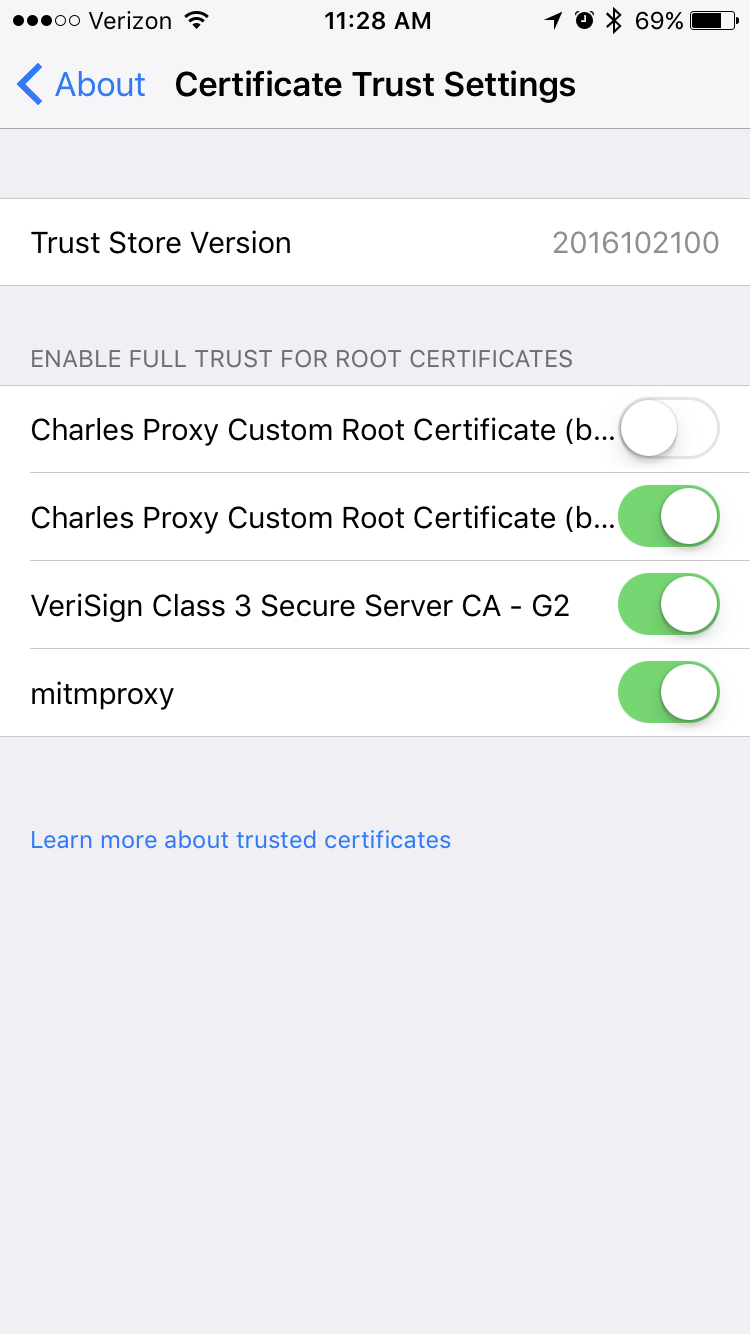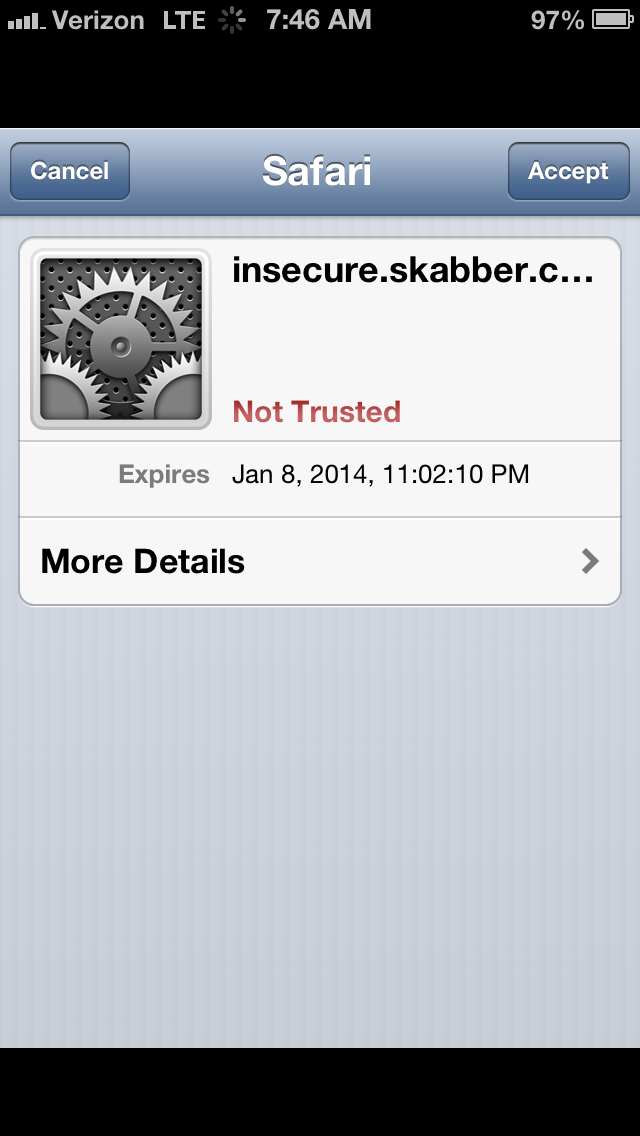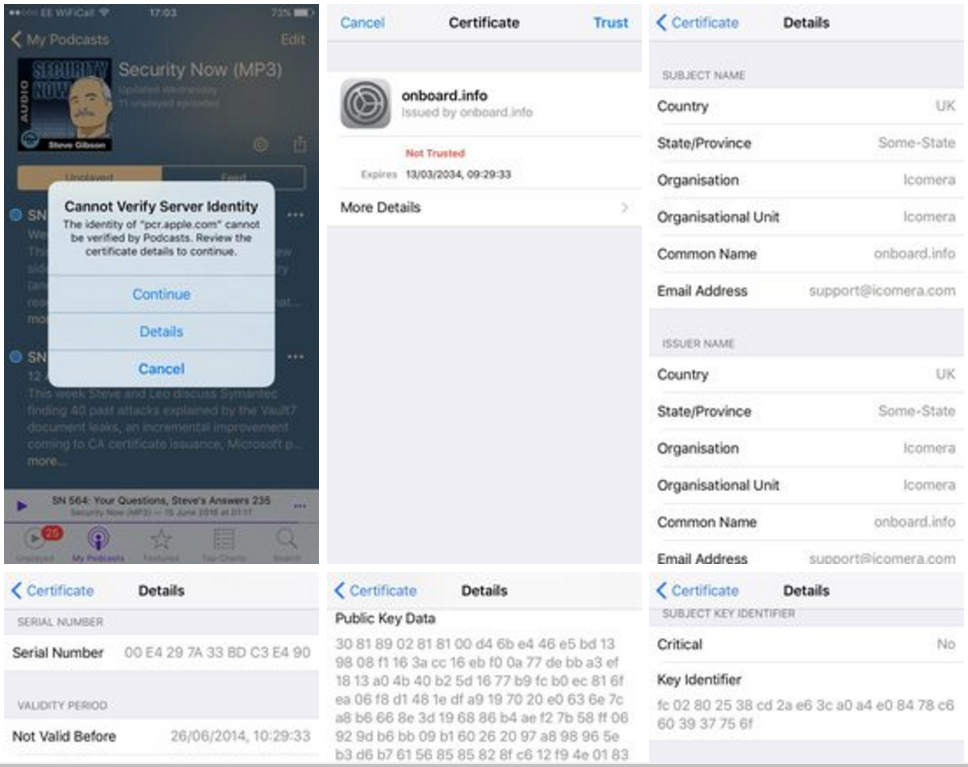What Is The Screw
Exactly when an iPhone activity to connect with a mail server securely, itll bring the servers SSL backing and check on the off chance that it is strong. Accepting that it notices the confirmation ended, or not matching the region name, or not supported by an outstanding association, itll mark the cert as problematic.
We see this screw up regularly when:
- The mail servers statement is changed , or
- One more record is being the course of action in iPhone, or
- After a record movement
The slip-up can appear while using any mail server. It even springs up with popular mail servers like eas.outlook.com, imap.gmail.com, etc also.
How Do You Trust Manually Installed Root Certificates In Ios
If your users are on iOS 10.3, they will need to follow the following steps to trust a certificate included in a profile
If you are dealing with a large number of organization-controlled devices, you may want to consider using Apple Configurator or Mobile Device Management. Both of these tools are geared towards enterprise, and will automatically trust any included certificates.
Re-Hashed is a regular feature on Hashed Out where we feature an older article that some of our newer readers may not have had an opportunity to read yet. We also take a few minutes to update it as needed. We hope you enjoy, and thanks for reading!
How To Trust A Certificate On Ios And iPhone Devices
Contact Us
In this document, we will explain when you need a developer certificate, how to find and configure it.
If you are trying to install an app, and you encounter a message similar to the one below, you will need to install a developer certificate and to trust the enterprise that created it.
You can find your certificates in settings as well as activate a new one. Here are some quick steps on how to do it:
You May Like: How To Update Carrier Settings On Itunes
Trust Manually Installed Certificate Profiles In Ios And iPados
In iOS 10.3 and later and iPadOS, when you manually install a profile that contains a certificate payload, that certificate isn’t automatically trusted for SSL.
This article is intended for system administrators for a school, business, or other organization.
You must manually turn on trust for SSL when you install a profile that is sent to you via email or downloaded from a website.
If you want to turn on SSL trust for that certificate, go to Settings > General > About > Certificate Trust Settings. Under “Enable full trust for root certificates,” turn on trust for the certificate.
Apple recommends deploying certificates via Apple Configurator or Mobile Device Management . Certificate payloads are automatically trusted for SSL when installed with Configurator, MDM, or as part of an MDM enrollment profile.
How Do I Fix Not Trusted Server Certificate On iPhone

4.6/5What To Do When Your iPhone Cannot Verify Server Identity
Besides, how do I trust a certificate on my iPhone?
If you want to turn on SSL trust for that certificate, go to Settings > General > About > Certificate Trust Settings. Under “Enable full trust for root certificates,” turn on trust for the certificate. Apple recommends deploying certificates via Apple Configurator or Mobile Device Management .
Furthermore, why does it keep saying verification failed? They try to connect to iTunes and Apple Store from their iPhone settings and instead see the error connecting Apple ID verification failed message. Readers often see this message after a restore or iOS update. Usually, it means that your device is not allowing you to connect to Apple’s iCloud verification servers.
Moreover, how do I verify my mail server on my iPhone?
How do I trust certificates on iPhone iOS 13?
You May Like: Can I Screen Mirror iPhone To Samsung Tv
What Details Are In A Digital Certificate
In short, a digital certificate has the following details.
- Who issued the certificate? It may be VeriSign, DigiCert, GlobalSign, or Thawte. These are the companies that, after due process, determined the validity, trustworthiness, and related credibility of the website.
- To whom the certificate is issued? It is the website owner or organization to whom the certificate belongs. Ensure it matches the name of the website or the parent company or the name you expect when you visit that site.
The expiration date of the Certificate: This is mostly one to two years, but sometimes it can be longer than this.
Trust The Certificate In Ios
Cannot Verify Server Identity. The identity of “mail.example.com” cannot be verified by Mail. Review the certificate details to continue If you’re receiving this or a similar error on your iOS device, follow these steps:
You can locate the box### from your email settings. To navigate there, follow these steps:
If the Trust button is missing or greyed out, continue to the steps below:
Option 1:
Also Check: How To Play 8ball On iPhone
Use A Terminal Command To Bypass The Trust Prompts
If nothing else works, you can disable the Trust This Computer prompt entirely for your Mac. I dont recommend this since it makes your data less secure, but you can try it if nothing else works.
Be wary of entering Terminal commands you find online. If you misspell a commandor enter a bad command correctlyyou could cause irreparable damage to your operating system.
Before going any further, make a backup of your Mac and your iPhone, iPad, or iPod touch. Then proceed at your own risk.
Use these commands to disable the Trust This Computer prompt:
What If I Cant Reset The Trust This Computer Settings
If your iPhone or iPad still connects to computers without asking you to trust them first, you might need to take more extreme steps to reset your settings.
Sometimes this happens when theres a bug in your devices operating software. But it can also happen when youre running a particularly old version of iOS.
Follow the steps below to fix it.
Read Also: Can I Screen Mirror iPhone To Samsung Tv
There Are Lots Of Companies Abusing Certificates
Facebook isn’t the only culprit abusing certificate licenses. For another big name example, Google was doing the exact same thing as Facebook, using a root CA certificate to grab any data going to and from the device for deep packet inspection. And while “trusted” root certificates are the biggest things to worry about, there are regular certificates as well as configuration profiles with or without them.
Anonymous program participants were using the Developer Enterprise Program to distribute porn and gambling apps, and shady developers took advantage to hand out cheating-based versions of popular apps such as Pokémon Go and Angry Birds, as well as pirated versions of paid apps like Spotify and Minecraft.
Unapproved app stores such as TutuApp, Panda Helper, AppValley, and TweakBox, as well as beta-testing platforms BetaBound, uTest, and Applause , all require a profile installation, usually with a certificate . The same goes for the apps they distribute, as well as solo apps found online. These profiles are easily installed just by tapping on a link in Safari.
What If My iPhone Keeps Asking To Trust This Computer
Some of you might be experiencing the opposite of this problem. Rather than worrying about your iPhone or iPad trusting public computers, it nags you to trust the same computers every time you try to use them.
After you tell your device to Trust a computer once, it shouldnt ask you again unless you reset the settings.
But if that does keep happeningor if your device never agreed to trust your computer in the first placeyou might be able to fix it with the tips below.
These tips also work if your device keeps asking, Do you want to allow this computer to access information on the iPhone?
Don’t Miss: How To Play Pool On iPhone Messages
How To Register Self
Apps should communicate securely via SSL with their backend. Self-signed certificates are an inexpensive option to use SSL communication also in development environments.
WebSocket network error: The operation couldnt be completed.
The error code 9807 points to an invalid certificate chain because your self-signed certificate wasnt based on one of iOSs trusted root certificates .
So how to make iOS accept your self-signed certificate?
First, email your root certificate to yourself. Next, open the email on your phone, and click the attachment. This will open the iOS Setting up and offer you to install the certificate as a Profile.
Second, instruct iOS to fully trust the installed root certificate. For this, open again the iOS Settings app. Then navigate to General > About > Certificate Trust Settings. In the section Enable Full Trust for Root Certificates, enable your root certificate.
With this, your app can connect now with the self-signed certificate to the backend.
Happy coding!
How To Check Your iPhone Profiles & Other Certificates

To view any existing profiles and/or certificates on your device, go to the Settings application, tap on “General,” and scroll down to “Profile/s.” If there is not “Profile/s” section, you have none installed. If you do see it, tap on it to view them.
On this page, there can be three different types of profiles, each which can include provisions for settings on your device as well as certificates. They are configuration profiles, mobile device management, and enterprise apps.
Recommended Reading: What Does Soundcheck On iPhone Do
Reset The Trust This Computer Setting On Your iPhone Or iPad
Dan Helyer December 8, 2019
Your device asks if you trust this computer whenever you connect it to a new Mac or PC. If you tap Trust, it shares data with that computer. You can reset the Trust This Computer settings on your iPhone or iPad at any time.
Its a good idea to reset the trusted computers if your device trusts computers in a public place or if you plan to get rid of your own computer. Try to avoid trusting computers in the library, at work, or at school.
Find out how to reset the trusted computers for your iPhone or iPad below.
Contents
How Do I Verify Certificate On iPhone
You can verify that the certificate is installed by going into Settings > General > Profile. In iOS 10.3 and later, you will need to manually trust the installed certificate by going to Settings > General > About > Certificate Trust Settings and enable trust for that certificate.
Don’t Miss: How To Spoof Pokémon Go iPhone
How To Check Your iPhone Root Certificates
Don’t know if you’ve downloaded a profile with a root or regular certificate on your device? Luckily, it’s easy to not only check but also to remove them from your iPhone. First, to check if you have any trusted root CA certificates, go to Settings > General > About > Certificate Trust Settings.
If there are any here, they’ll appear under the “Trust Store Version.” If they’re green, they’re running right now. Root certificates here that were deployed via Apple Configurator or Mobile Device Management are automatically trusted. You can toggle it off to disable it, but that won’t delete it, so you’ll want to view the next section for that.
How To View Certificate On iPhone
It was easy and straightforward to see certificates on the computer version of Safari, Chrome, and other browsers. But, doing so on the iPhone is a bit complex. When you tap on the padlock icon in Safari on your iPhone, it opens up the keyboard instead of showing the certificate. But we have a solution.
Step #1. Open App Store and .
Step #2. Launch this app and tap Understood.
Step #3. Here you can input the website address and quickly view the certificates.
Alternatively, you can also use TLS Inspector extension inside Chrome or Safari to see the certificate there. You do not need to open this app. Read on.
Also Check: Can I Plug My iPhone To My Tv
Do I Need Security Certificates On My Phone
Android uses certificates with a public key infrastructure for enhanced security on mobile devices. Organizations may use credentials to verify users identity when attempting to access secure data or networks. Organization members often must obtain these credentials from their system administrators.
Erase All Content And Restore Your Device
In extreme cases, you may need to completely erase your device and restore it from a backup. This step is certain to reset the trusted computers, but it can also be rather time-consuming.
Be sure to make a new backup of your iPhone, iPad, or iPod touch first. Then follow the steps below to erase it.
Read Also: How To Delete Hidden Apps On iPhone
View All Certificates Inside Firefox
Step #1. Inside Firefox, from the top right.
Step #2. Click on Preferences. It will open in a new tab.
Step #3. Now click Privacy & Security.
Step #4. Scroll down and under Certificates, click on View Certificates
Step #5. Now from this pop-up double click on any certificate to open all its details.
The Security Risk Of Profiles

Profiles are configuration files which make it easy to deploy custom settings to an iPhone or iPad. These profiles can contain information needed to access a network or configure email accounts.
Corporations and universities use profiles to easily deploy the settings needed to get a new device onto their network. Consumer-facing services like Xfinity Wifi and Manhattans LinkNYC use profiles to allow users to get on their public wifi.
But many users may not realize how powerful profiles can be. Many profiles, such as this one used by Comcasts Xfinity Wifi, contain root certificates which can be used to establish secure connections.
Trusting a malicious root is one of those nuclear-level game over scenarios. In fact, Chromium acknowledges that if an attacker can install a root onto your device, there is nothing the browser can do to protect you.
On Windows and OSX, that is a reasonable. Trusting a root on Windows, for instance, takes quite a few steps including downloading the root, opening the file on your computer, and then going through an import wizard.
On iOS, it is a different story. In Safari, just clicking a button on a webpage can prompt a system dialog to install a custom profile which can include root certificates for your device to trust. While this still requires explicit user action, the simplicity of iOS makes it much easier for a user to naively follow this process thinking its the normal or proper thing to do.
You May Like: How To Use Airplay On iPhone 11
Five Tips For Using Self Signed Ssl Certificates With Ios
December 12, 2013 inHttpWatch , iOS , SSL
SSL certificates are relatively cheap to purchase, but sometimes it would be easier if you could create your own. You might need to setup SSL on development and test servers that have different host names or on systems that will only ever be accessed on your local network.
Self-signed SSL certificates allow you to quickly create certificates for free, without having to pay a Certificate Authority or comply with any auditing requirements.
The downside of using self-signed certificates is that browsers will not automatically trust sites that use them. In Mobile Safari you would see an error like this:
The HttpWatch iOS app provides some more detail:
The rest of this post provides tips on how to setup iOS to avoid these errors and how to simplify the creation and management of self signed certificates.